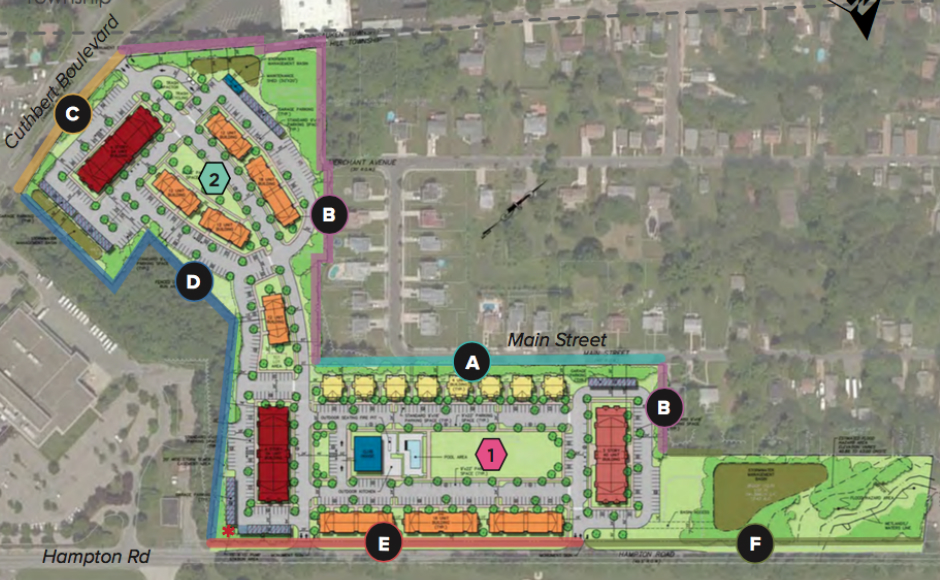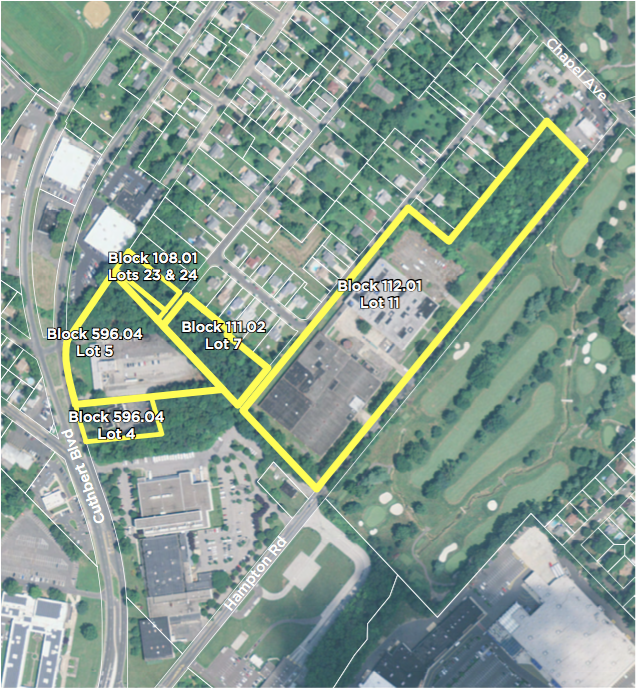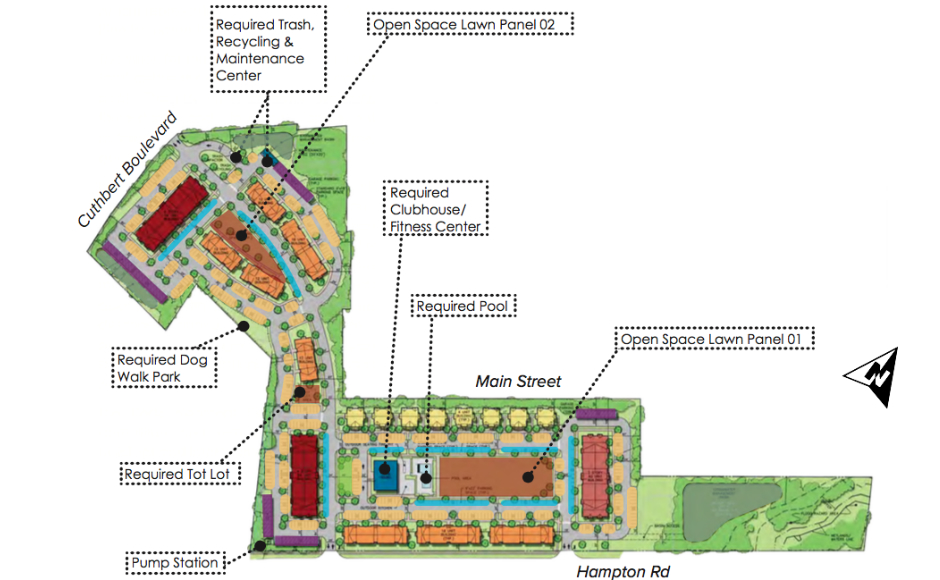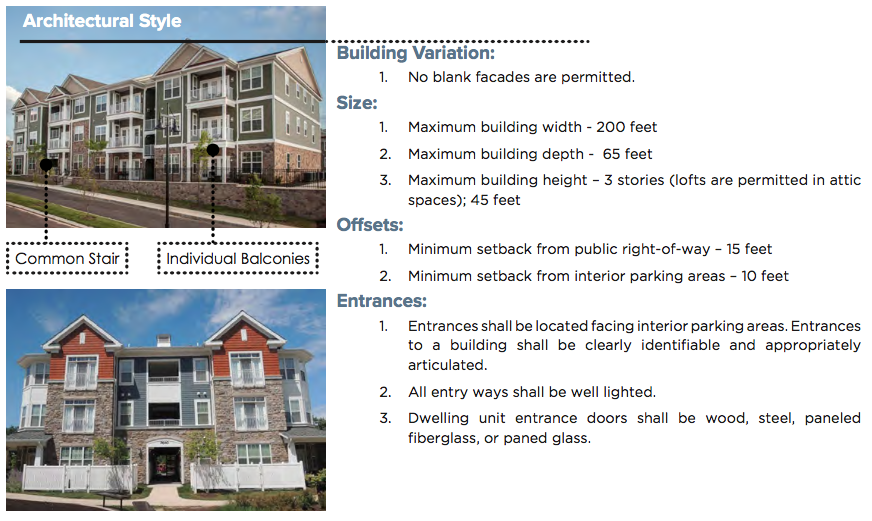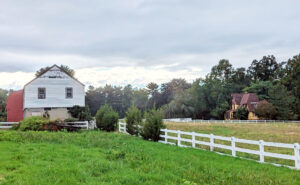The project is the result of a settlement that preserves Woodcrest Country Club and redevelops two former commercial sites between the Merchantville Country Club and the Still Park neighborhood.
By Matt Skoufalos | March 21, 2017
A settlement agreement that resolved a builder’s remedy lawsuit over Cherry Hill’s affordable housing obligation and preserved the Woodcrest Country Club as open space will be fulfilled in part with a 300-unit housing project at Hampton Road.
That’s after the township planning board approved a redevelopment concept Monday that would convert a little more than 20 acres of unused commercial space and undeveloped woodland into a 20-building housing track.
The area, which is bordered by Hampton Road, Chapel Avenue, and Cuthbert Boulevard, has been studied by township officials for more than two years.
Cherry Hill Land Associates, which owns the Woodcrest Country Club, has development rights to the parcel, after having brokered a deal to preserve the club in 2015.
Planner Bob Melvin of Group Melvin Design, which prepared the site study, said that redeveloping the area would help preserve open space elsewhere in the township while returning a debilitated property to productive use.
“Cherry Hill as a whole does not have a lot of land that is not developed,” Melvin testified Monday evening. “The spaces that are not developed are very precious, even when they’re in private ownership.”
The bulk of the parcel is a 188,400-square-foot vacant industrial property that had operated as W.B. Saunders Medical Publishing Company from 1955 to 1986, and then by DKM Properties/Princeton Storage Specialists from 1987 to 2007. However, the lot has been unused since 2002, and its disrepair was cited in Melvin’s study, which highlighted the presence of mold, asbestos, and possible chemical contamination from its days as a publishing plant.
Another piece of the study area used to be a fleet maintenance service center for New Jersey Bell Telephone Company.
Sold to a developer in 2009, it has been unoccupied since, and was at one point being used without permission by a landscaping company that was later ordered to vacate the premises.
Melvin’s report notes that the parcel had accrued years of property violations, including citations for accumulated trash and dead trees, and that the antiquated structures on its lots made the site a poor candidate for reuse in a contemporary commercial capacity.
Two other lots in the redevelopment zone include inaccessible woods that Melvin noted are unlikely to be otherwise commercially viable.
The redevelopment plan outlines a 300-apartment site with a variety of buildings: eight two-story quadriplexes (32 units), eight three-story walk-ups (120 units), one three-story elevator apartment building (40 units), and two four-story elevator apartment buildings (108 units). Fifteen percent of those units would be set aside as affordable housing; were the development to consist of for-sale units, that obligation would rise to 20 percent.
The plan also includes a half-acre green space and smaller pocket parks, a fitness center and outdoor pool, and indoor and outdoor gathering areas. It will have a dog park and a playground for children. Parking will include a mix of on-street spaces, parking lots, and four concrete garages.
Melvin spoke about how the layout prepared by his firm seeks “a contextual buffer between the development and the adjacency,” aligning the two-story buildings along the Main Street neighborhood border and requiring architectural fronts to buildings facing Hampton Road.
“[The plan] does require certain qualities to that architecture,” Melvin said.
“It requires windows so they’re not blank walls. It also speaks to landscaping within the 25-foot transition space and a low aluminum fence to create that sense of front-yard transition.
“When parking butts up against an adjacent parcel, there’s a more robust requirement and a more robust distance between the property line and the edge of the site.”
The potential for greatly increased traffic volume in the area was a concern cited by nearly every one of the 15 or so township residents who spoke at the meeting. Others worried about the plan to clear out the undeveloped woodlands at its center. Most of them objected to the density of the project.
“Being a lifelong resident of Cherry Hill, living in that area, never left, I have some serious concerns,” said resident Deborah Hill. “Hampton Road is not big enough to have another access road into Chapel Road and the light at the inspection station. Sometimes it takes me 20 minutes to make a left to go home with traffic now. On the other opposite side, you’re coming onto traffic from Magnolia; it’s a one-way street.”
“One of the things I appreciated most about moving into that neighborhood was the neighborhood,” said Darryl Jackson. “There’s not a lot of traffic coming through my neighborhood. There’s not a lot of strangers in my neighborhood. The people who are in my neighborhood are from my neighborhood, and I feel like this is going to be an intrusion to us.”
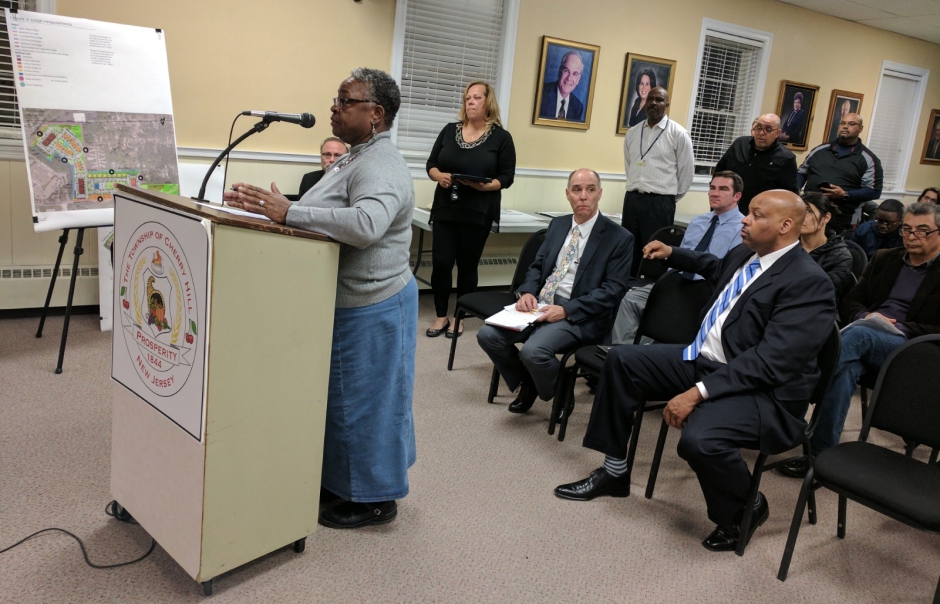
Cherry Hill resident Deborah Hill testifies at the township planning board meeting. Credit: Matt Skoufalos.
Jesse Randolph asked what value a large rental community could add to the neighborhood.
He said that many of the residents still struggle with property damage and cleanup from a protracted legal battle with the last developer in the area, Quest Builders of Evesham.
“If this was a housing development, we probably wouldn’t be here,” Randolph said.
“Since 2005, so many of these homes are upside-down in value. What does an apartment complex add to these homes in turn of value?”
Resident Pat McCargo said that the fallout from the fight with Quest was related to cleanup from an underground waterway in the neighborhood. That led to homeowners having to take on responsibility for maintenance of a drainage unit at their own cost, she said.
“That was all done with the trust of the residents there, and they were lied to,” McCargo said.
Woodbury resident John Tierney worried that the viability of the nearby Merchantville Country Club could be threatened if the construction leads to a widening of the roadways surrounding it.
“I think you’re going to be dealing with an eminent domain case with [the county government] taking a chunk of our second hole, which is our signature hole,” Tierney said.
Resident Alicia Slattery said she was happy to see that “something is being done and developed.
“We’ve been in our home for 23 years,” Slattery said. “This is the first time the township has taken such an interest in this area.”
In response, members of the planning board expressed feeling bound by the terms of the settlement agreement. Referring to the scope of the project, board member Marlyn Kalitan talked about being “stuck with this 300 number”; others thanked the community for their comments and encouraged them to return to present their concerns when Cherry Hill Land Associates seeks its site plan approval.
Cherry Hill Deputy Director of Community Development Lorissa Luciani tried to assuage concerns about the redevelopment plan by pointing out that the acreage across which it is structured contains a significant amount of open space.
She noted that the dilapidated warehouse and vacant commercial buildings on the site could be returned to a productive reuse that they would not otherwise without the redevelopment plan. Without the use change of a redevelopment overlay on the site, only commercial properties would be able to operate there, and the condition of the facilities themselves makes that unlikely.
The vote passed unanimously with the exception of Chair John Osorio, who recused himself from the proceedings.

